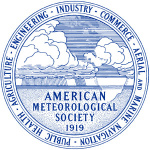- Industry: Weather
- Number of terms: 60695
- Number of blossaries: 0
- Company Profile:
The American Meteorological Society promotes the development and dissemination of information and education on the atmospheric and related oceanic and hydrologic sciences and the advancement of their professional applications. Founded in 1919, AMS has a membership of more than 14,000 professionals, ...
A surface with irregularities sufficiently small to be entirely embedded in the laminar sublayer.
Thus, the smoothness of a surface will depend on the Reynolds number. The irregularities are taken to be sufficiently dense and similar so that only the average height need be specified. A surface is aerodynamically smooth if
<center>[[File:ams2001glos-Ae13.gif
Industry:Weather
A version of the radiative transfer equation that predicts the luminance due to airlight (''L<sub>a</sub>'') in the direction of a perfectly black object near the horizon.
''L<sub>a</sub>'' can be used to calculate daytime visual range. For horizon sky luminance ''L<sub>h</sub>'', horizontally uniform extinction coefficient σ, and distance x from the observer:
<center>[[File:ams2001glos-Ae14.gif
Industry:Weather
An equation used in predicting the night visual range of self-luminous targets.
Assume a light source at distance x from an observer and having (monochromatic) luminous power ''P<sub>v</sub>'' in that person's direction. Then for uniform extinction coefficient σ, the illuminance ''E<sub>v</sub>'' reaching the observer is
<center>[[File:ams2001glos-Ae15.gif
Industry:Weather
A mathematical function with symbol ε''<sub>ijk</sub>'' defined to switch between the discrete values of +1, 0, and -1, depending on the values of the three indices ''i'', ''j'', and ''k'':
<center>[[File:ams2001glos-Ae16.gif
Industry:Weather
Changing the amplitude of a carrier wave by some means so that the resultant waveform transmits a signal conveying information.
For example, if the carrier wave with angular frequency ω is cos(ω''t''), the corresponding amplitude-modulated signal is
<center>[[File:ams2001glos-Ae19.gif
Industry:Weather
In the Fourier or spectral analysis of two time series, a measure of the correlation between the two series as a function of frequency or wavelength, but ignoring any phase differences between the two time series.
It is defined as
<center>[[File:ams2001glos-Ae20.gif
Industry:Weather
Often the greatest magnitude at a given point of any spatially and temporally varying physical quantity governed by a wave equation; can also mean the spatial part of a time-harmonic wave function.
For example, in the time-harmonic (or sinusoidal) scalar wave function with circular frequency ω,
<center>[[File:ams2001glos-Ae17.gif
Industry:Weather
In Newtonian mechanics the angular momentum (or moment of momentum) '''L''' about a point O of a body with linear momentum '''p''' is the vector cross product
<center>[[File:ams2001glos-Ae21.gif
Industry:Weather
A force (mass times an acceleration) introduced on the side of an equation on which all supposedly real forces appear.
For Newton's dynamical law of motion for a body of mass m acted on by a force '''F''',
<center>[[File:ams2001glos-Ae23.gif
Industry:Weather
For a rotating planet such as Earth the resultant of the force (per unit mass) due to gravity and the centrifugal force.
Apparent gravity is given by
<center>[[File:ams2001glos-Ae26.gif
Industry:Weather
